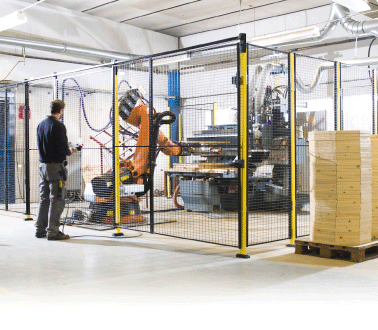Machine guarding used in industry and business is an important safety issue that is subject to numerous compliance standards and regulations.
According to the Health and Safety Executives statistics, there were 31 fatal injuries during 2011-12 in the manufacturing industry. Four of these fatal injuries were caused by contact with machinery that was moving. There were also over 3500 non-fatal major injuries and over 14,100 injuries that lasted over three days.
Machinery risks
Machinery can cause injury in a number of ways:
- The sharp edges on a machine can cause cuts, stabbing and severing injuries
- Dangerous machinery can cause employees to be injured or struck by machinery moving parts. Parts of an employees’ body can also become trapped or inadvertently drawn into part of the machine such as belts and rollers
- A part of the machinery including materials being processed by the machine and emissions such as sparks or steam can be scalding or freezing to cause scalding or burns to the skin
- The machine maybe faulty or not functioning properly which could cause injuries
- The employee may not be experienced enough to work the machine and have little or no training to use it
- There may be invisible emissions from the machinery including radiation and noise.
So the problems and risks associated with machinery are large, varied and real ones. Accidents can be caused because of badly maintained or completely missing machine guarding on machinery that is dangerous to employees. What can be done to safeguard against injuries involved with machinery in the workplace?
Assess the risk in the workplace
The first thing to do is to carry out an extensive risk assessment involving all machinery on-site. This will assess the degree and probable risk of any type of injury occurring. A risk assessment is a major undertaking and should be carried out thoroughly to ensure that all factors and probabilities are identified and assessed.
A risk assessment should include checking the machine is complete and free from faults and defects and to also assess the machine guarding that is being used for a particular machine. These should be assessed as to whether they are adequate enough, they are not faulty or defective. All of the machines should also be checked for maintenance issues and to investigate how and when the machinery is serviced and checked for faults. Around half of all accidents involving machinery are caused when machine maintenance is being carried out so the actual maintenance process itself should be assessed to check that it is safe.
Machines should also be checked that they are properly installed, stable and fixed securely where required. The actual machinery for the job involved must also be assessed that it is fit and proper for use and the right type of machine for the job. The location of machinery should also be risk assessed to ensure that customers, visitors and employees are not exposed to danger.
When the machinery is examined and assessed, the risk should be risk graded from minimal to high risk. Risks that are considered dangerous should be addressed with appropriate actions to reduce the risk. Where the risk would be helped by machine guards, this should be implemented as soon as possible and the machinery not used until the proper action has been put in place.
Well designed machine guards should allow machines to be unloaded, loaded, cleaned and maintained in a safe way without exposing employees to hazards and danger. There may also be an issue and risks around badly designed machinery safeguards. These may be inconvenient, not suitable for the risk and danger presented by the machine and not easy to use or easily over-ridden, which could encourage your workers to risk injury, become lax and break the law.
Machine guarding
Machine guarding is designed for both fixed and moving machinery and there are regulations for the fixings for fixed guards. There are also standards around the safety distances to prevent hazard zones being reached by parts of the body. Machine guards should be properly designed for machines and come in a range of materials such as mesh, solid steel or polycarbonate. You will need to get expert help from machine guarding suppliers as each guard will provide bespoke safety, protection, security and visibility depending on the machinery, risk and access.
As well as actual machine guarding, access control should be assessed. This ensures that if access is required it is controlled and access can only be granted in safe conditions. The risk assessment will reveal the level of security required in each environment. With interlocking controls, the machinery can only be approached when it is in a safe condition and safe to do so.
In some areas that are identified high risk, a key exchange system may be required. This enables the machine to be shut down and prevented from restarting. Panel fixings for the machine guards will also need to adhere to latest machinery directives.
We provide machine guarding with a machine guarding panel options. More details on our machine guarding here.


